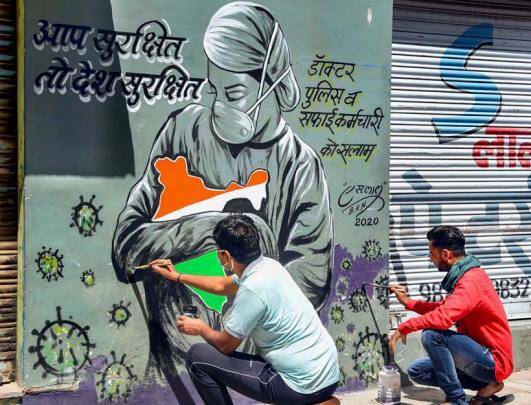COVID-19 is a public health crisis of unprecedented magnitude. Individual and collective behaviors are contributing significantly to the steep upward curve of COVID-19 incidence as people struggle to adhere and adapt to social distancing, shelter-inplace measures, and sudden financial uncertainties.
The arts are one of the most powerful means for communication and coping we have at our disposal today. With its vast array of arts and cultural resources, the United States is well-equipped to lead the world in mobilizing artists and the arts sector for communication, and to help people to connect, cope, and be well in the short and long term.
WHAT YOU CAN DO NOW
Engage and pay artists. Optimize audience interest, relevance, reach, social learning, and
collective behavior change by engaging artists at every stage of health communication planning and delivery.
Collaborate. Ensure accurate, targeted and accessible messaging through collaboration across public health and arts sectors. See the popular Ghen Co Vy handwashing dance and the Philadelphia Street Department’s partnership with Mural Arts.
Source reliable information. Craft arts-based communications using up-to-date information from the CDC or the Ad Council’s COVID-19 Toolkit.
WHAT WE LEARNED FROM THE EBOLA PANDEMIC
In 2014-2015, artists in West Africa demonstrated the power of the arts to disseminate critical health information to help stop the spread of Ebola. Swift investments by UNICEF, USAID, and others enabled rapid and broad communication through popular music, murals, radio and television dramas, and film festivals. Popular musicians wrote, performed, and recorded songs with lyrics informed by UNICEF’s public health experts, and they topped the charts in Liberia within days. These collaborations were highly effective in shifting widespread beliefs and behaviors associated with the transmission and care of the virus.
Artists are influencers and trusted community members, which is especially important at times when trust in government institutions is in question.
HOW THE ARTS ENHANCE CONNECTION, COPING, AND WELLBEING
– Through social engagement, emotional connection, learning and enjoyment.
– By providing direct physical and mental health benefits, including physical activity, relaxation, expression, connection and meaning-making.
– By activating the values we need most in difficult times, including joy, hope, meaning, empathy and resilience.
We turn to the arts in challenging times because they help us to heal, to share stories, to make meaning, and to drive collective action and social change.
Artists in the United States have mobilized quickly in response to COVID-19 with efforts addressing social isolation, mental health and resilience among elders, children, healthcare workers, and whole communities. These approaches also help raise awareness of the heightened structural inequities that have been revealed and exacerbated by this crisis. Numerous populations— including people with disabilities, rural communities, older adults, and those with financial insecurity— have faced similar challenges for decades and have significant knowledge and leadership to contribute to new collaborations. And, since artists themselves are among those facing extreme financial uncertainty, these arts-empowered approaches to communication and coping can also help to employ artists and to sustain arts organizations at this critical time.
Now more than ever, the power of the arts are needed to help build a more equitable, caring and humanistic world.
ANALYSIS
In this “call for collaboration,” the University of Florida(UF) points out that art plays an invaluable role in the livelihood of people during situations of distress like the current pandemic. I found it profound to examine art’s impact on the spread of information and the remedies it provides with respect to peoples’ well-being. Artists have the power to shape what move people and shape what some believe in ways that politicians or other officials cannot.
This article highlights the urgency of support art makers and encourage connection. That is, to encourage institutions to back artist collaboration and to utilize the power art has to connect people. While stating this, UF makes note of the fact that art professionals have also sustained negative impacted from social distancing that can be helped.
In short, UF puts a spotlight on the benefit for society to enable artists during the pandemic, and how it also helps sustain artists.




